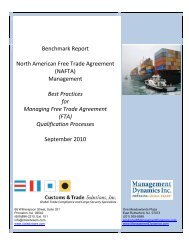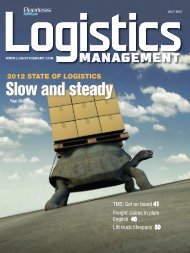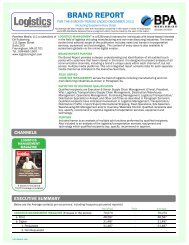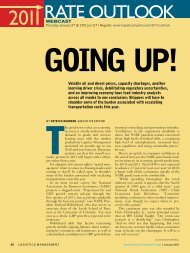Download - Logistics Management
Download - Logistics Management
Download - Logistics Management
You also want an ePaper? Increase the reach of your titles
YUMPU automatically turns print PDFs into web optimized ePapers that Google loves.
2012:<br />
Looking back and ahead<br />
By John A. Gentle, DLP<br />
here’s what my colleagues and i saw this year in<br />
logistics and transportation management and what<br />
we expect next year—along with some suggested<br />
actions on important issues.<br />
Not unlike 2011, rising fuel, equipment, health<br />
care, and driver wages generally pushed over-the-road<br />
freight rates higher. While bidding did not disappear,<br />
the more prudent shippers chose to work closely with<br />
their carrier and 3PL business partners to protect<br />
capacity. While demand was occasionally tight in<br />
the first half of the year, the quest for resources in<br />
the third and fourth quarters—apart from hurricane<br />
Sandy—did not tax the system.<br />
Jeffery Brashares, senior vice president of sales for<br />
TTS and foremost industry expert, says that intermodal<br />
continues to be the bright spot in rail growth and forecasts<br />
that it should continue into 2014, albeit at a slower<br />
pace. Service excellence, more shippers going green, box<br />
capacity, and competitive price have all helped drive this<br />
growth and have provided savvy shippers with savings<br />
opportunities this year and into the future.<br />
Albert Saphir, principal at ABS Consulting, reports<br />
that for shippers that negotiated reasonable base rates<br />
for longer-term stability on ocean freight, not much<br />
changed on major lanes—although rates did go up and<br />
down again a few times based on a number of factors.<br />
However, Asian ocean rates tied to spot market or lowend<br />
margin pricing did see a significant jump after the<br />
first quarter of 2012. Saphir feels that 2013 should be<br />
pretty much the same. With mixed economic forecasts,<br />
ocean carriers will try to manage available capacity, especially<br />
on refrigerated containers, to improve their ROI.<br />
Over the past year, shippers continued to look to<br />
third party logistics providers (3PLs) to reduce headcount<br />
as well as cut fixed warehouse and transportation<br />
assets while improving service. The 2012 3PL<br />
Study, headed up by Penn State University’s John<br />
Langley, suggests that 65 percent of the shipper participants<br />
in the study increased their use of 3PLs with<br />
86 percent success. Notably, most participants sought<br />
3PLs for traditional operational and repetitive activities<br />
such as transportation and warehousing, freight<br />
John A. Gentle is president of John A. Gentle & Associates, LLC,<br />
a Supply Chain consulting firm assisting shippers, carriers, 3PLs,<br />
and distribution centers in the management of their Logistical<br />
disciplines. A recipient of several industry awards, he has more<br />
than 40 years of experience in transportation, warehousing, and<br />
materials management. He can be reached at jag@RelaTranShips.<br />
forwarding, and customs brokerage. To a lesser extent,<br />
shippers turned to 3PLs for value added services<br />
such as reverse logistics, transportation planning and<br />
management, inventory cross docking, packaging, and<br />
labeling.<br />
Taking all of this into consideration, this is what I<br />
believe will take place in 2013:<br />
<br />
and non-critical areas to relieve pressure on their company’s<br />
working capital.<br />
<br />
to retain CSA qualified drivers and upgrade their<br />
equipment. They will be even more selective about<br />
their customers. If you think any old carrier will do,<br />
think risk mitigation….and think again.<br />
ala carte rate structure will be<br />
expanded with accessorials that are fair to both parties,<br />
and shippers will urge their sales team to offer<br />
new delivered options to clients.<br />
<br />
<br />
<br />
via third parties will continue to create and maximize<br />
carrier productivity and control costs.<br />
<br />
3PLs will need to monitor carrier BASICs rigorously<br />
and consistently. Supporters of the new administration<br />
will pressure CSA to eliminate the 34-hour restart<br />
and reduce HOS. While implementation would be<br />
delayed, begin looking at the impact on your backhauls<br />
and recognize where shifts in shipper networks<br />
could leave you vulnerable. Continue to support<br />
NITL, NASSTRAC, and the ATA as they push for a<br />
reasonable ruling.<br />
Savvy shippers will also spend more time on contingency<br />
planning for extraordinary natural factors, unanticipated<br />
distribution shifts, and systems outages that<br />
have the ability to stretch and break supply chains. If<br />
you can’t do this in-house, seek outside help.<br />
The big difference between my thoughts and yours<br />
is that I get to write and lament about them. As for you,<br />
this is your livelihood. Your job is strategic, not transactional.<br />
Work hard to understand the elements that your<br />
carriers and customers value, and measure your effectiveness<br />
in meeting and exceeding their expectations.<br />
Work aggressively to make sure your customers, carriers,<br />
and your boss can’t afford to operate without you. <br />
112 LOGISTICS MANAGEMENT WWW.LOGISTICSMGMT.COM | December 2012

















